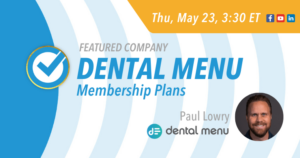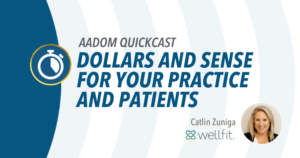Dental Memberships: DIY or Third-Party?
(Part 2 in a 3-part series)

Does your practice have patients concerned about not having dental insurance benefits? Are you a part of insurance networks with poor reimbursement rates? Is the practice at risk of being unable to hire high-quality associates due to the constraints on their earning potential due to low contracted service fees?
If so, you might consider implementing an in-office dental membership program. There are several considerations to keep in mind when implementing a dental membership plan, which will assist you in deciding whether to do it yourself or use a third-party administrator.
In our practice, we discovered great benefits when implementing an in-office dental membership plan. Patients who have dental benefits visit the dentist more often than those who do not and may have fewer health problems.
Individuals with chronic diseases but without dental coverage through Capital BlueCross had a seven percent higher rate of hospital stays than those with dental benefits.
Members who had dental coverage but did not use the benefit for preventive services had a 19 percent higher incidence rate of ED (Emergency Department) visits than those who took advantage of routine dental care.1
In-office memberships help to generate additional revenue each year through member renewals. Patients who participate in dental memberships and receive additional savings over out-of-pocket costs might also be incentivized to accept more proposed treatments. A 2020 McKinsey survey on loyalty programs found that members of paid loyalty programs are 60 percent more likely to spend more on the brand after subscribing, while free loyalty programs only increase that likelihood by 30 percent.2
Begin Your Research
The ideal plan is dependent on your current fee schedule as well as your existing patient base.
- Is your practice fee schedule up to date?
- How do your fees compare with other practices in your area with the same level of experience and training?
Check your Current Dental Terminology (CDT) service code fees by using Fair Health Consumer Dental website3 or by obtaining a report from National Dental Advisory Service (NDAS)4. If you haven’t updated your fees recently or if they are not in the same percentile range, and not appropriate for your dentist’s level of experience and training, then begin by correcting your fees.
- Is your active patient base accurate?
- Do you inactivate patients that you have not seen in 18 months or more?
Obtain an active patient report. Any patients not seen in the last 18 months should be considered inactive. Begin cleaning up your patient accounts and create a system for regular maintenance of your active patients.
Impress your doctor by compiling detailed reports. Compare these reports to show how a membership plan will benefit your practice:
- Frequency of services in a 12-month period.
- Look at a period of time when your practice didn’t have any substantial changes that might distort the numbers (i.e., COVID, DDS out due to illness, significant changes in provider staffing, etc.)
- The number of insured vs. uninsured patients.
- This will help you to determine your target audience as you begin to implement your plan.
- Your practice UCR preventive fees, in-network fees, and proposed dental membership plan fees.
- Frequency of visits for insured and insured as compared to recommended frequency.
Assemble the data in a logical way, comparing services, fees, and frequency of visits for insured, uninsured and potential membership patients. Schedule a meeting with your doctor and share how the practice and your patients may benefit by offering an in-office dental membership.
Now, decide if you will create your own plan or if you will use a third-party administrator.
The Do-It-Yourself Route
We realized there might be software features available that we could utilize to create our own membership plan. With a moderate investment of time and money, we initially thought we could utilize our existing software to create our plan.
Ask yourself, how much work, expense, time, and overall management will it take to create our own plan and to keep it running smoothly for the long term?
To build a membership plan without a third-party administrator, there are key tools and processes you will want to identify as well as questions you will want to answer, such as:
- Automated monthly/annual payments
- How to automate recurring monthly and annual payments such as ACH (automated clearing house) transfers and credit or debit card payments?
- What secure system will you use for storing payment information?
- Ideally, one good system, possibly with one’s existing software, would be used. Another option at a significant cost is building your own automated membership software program that integrates with your Patient Management Software (PMS).
- Note: Google Docs is NOT a secure mechanism for storing financial information.
- Key performance indicators (KPIs)
- We looked at service codes, descriptions, fees, the frequency a service was completed in 12-month period, and compared insured vs. uninsured.
- Legal advice for creating and managing membership contracts.
- Automation of recurring patient membership communication.
- Monthly and annual payments; renewals; late payments; inactive or expired credit cards etc.
- Marketing
- Can you effectively plan and implement your marketing?
- Do you have access to digital and print marketing materials?
- How economically can you create marketing materials?
- How will you develop materials that align with your branding?
- Can you do this in-office, or will need to hire out?
- Website integration or a separate platform for patients to access their membership accounts.
- Will online bill pay work through your existing system?
- Seek legal advice on your state’s regulatory requirements for startup and annual compliance.
- Does your team have the capacity to follow up on all of the above?
- At what cost?
Some of the above questions and considerations were easy to answer, while others were more difficult, more costly, and involved bringing in more consultants to help answer the questions we needed to answer to create our own plan. We quickly concluded the return on our investment was not worth the time, effort, and money it would take to build and maintain our own plan.
Third-Party Membership Plans
How will using a third-party administrator make your life as a manager easier and benefit your practice?
If you decide to use a third party, request a demo from all the companies you are considering. Ask lots of questions. Check out the company’s reviews. Ask your fellow AADOM office managers who they use and why. Find out how the company started, its philosophy, and plans for future growth and development.
Ultimately, we determined that Kleer would be the best fit for our practice. They answered the questions and offered more for us to consider. We could have invested in building our own in-office plan, but it would not be a wise return on our investment to try and recreate what Kleer had already developed.
Other Considerations
Keep in mind, whether you use your own membership or utilize a third-party provider, there are additional factors to consider and questions to be answered by yourself or the third-party company you are working with, such as:
- Growing the membership plan will take active effort, especially during the first 12 months. Still, appropriate pricing, clear marketing, strong staff training, possible incentives, and excellent team culture can help.
- Storing financial information in secure formats is critical.
- If you do not include a new patient program in your plan, evaluate when you would like to add one.
- Determine the financial structure needed to cover costs of new patients, new patient enrollment, services included, etc.
- Leverage credit card authorization templates and financial agreements from your dental association. You will likely need a tailored membership plan agreement reviewed by a lawyer.
- If you are in-network with any insurance companies, check your contract(s).
- Do you have any contract clauses precluding you from offering a membership plan in your practice?
In our practice, with staffing shortages and the overall complexities of managing our own plan, the decision to utilize a third party was easy. It was more cost-effective and relatively fast to implement. The legal, financial, and administrative aspects were all taken care of. The software and processes were already in place; all I had to do was follow directions.
Our onboarding representative walked us through every detail. We received training, customized marketing materials, and everything we needed to implement our specific membership plan. Once we were ready to begin enrolling patients, all we needed to do was educate our patients to the benefits and assist them with their enrollment.
Whether you implement your own or utilize a third-party provider, a successful dental membership plan may potentially produce more reliable revenue for the practice and discounted care, with a greater frequency of visits for patients, which are great things for the practice and your patients!
Please send me an email to request a copy of The Summary of Third Party Administered and Self-Administered Dental Membership Plans (Pros and Cons)
- Dental Memberships Part 1 – 3 Reasons – One Perspective
- Dental Memberships Part 3 – Six Best Practices
About the Author

Debbie Jones, RN MN, MAADOM, is the Practice Administrator for her husband Mike Jones’ General Dental Practice in Newport Beach, CA. Debbie has been an AADOM member since 2018, and in 2021 she earned her Fellowship (FAADOM) designation. In 2022 Debbie completed the requirements and successfully received her Mastership (MAADOM) designation. She is currently enrolled in the diplomate program and is on track to receive her DAADOM designation at the 2023 conference. Debbie loves learning and has attended every AADOM conference since she first joined the association in 2018.







